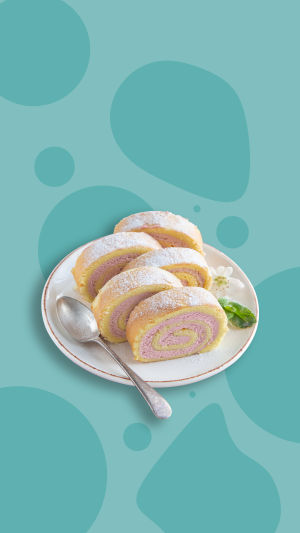Swiss rolls are a type of sponge cake. With jam and cream, some with chopped pulp rolled into a roll. Cocoa powder and coffee powder can be added to create a soft, spongy roll cake.
In the 19th century, it came along with doughnuts, Queen Victoria cakes, and more. The first country to have Swiss rolls is probably Austria in Central Europe.
The Swiss roll is usually a large flat cake wrapped in light cream, jam, or icing, rolled into long strips and cut, and sold in a spiral shape.
But no matter what the flavor, the signature Swiss roll is that the cake layer must be sponge cake. Sponge cake is a type of cake that originated in Spain in the 15th century.
It gets its name from its sponge-like structure, which is tightly organized and solid.
From the 19th century to the present, the Swiss rolls have developed different forms in different regions, although they may look similar.
There are two versions of the Swiss roll. One is the Swiss roll, a continuation of the Western style.
Originally available in original Swiss rolls and chocolate Swiss rolls, many different flavors have evolved, often incorporating seasonal foods to create new flavors, such as strawberry and chestnut.
The other is tiger skin cake rolls. The layer is golden with egg yolks and looks like tiger fur, while the filling is changed from light cream to old-fashioned white cream.
The most popular flavors in the UK are jam Swiss Roll and Chocolate Swiss Roll. Jam Swiss Roll, as the name suggests, is a sponge cake filled with jam and coated with a crust made of sugar or chocolate chips.
In southern Italy, especially in Sicily, the Swiss roll has its special form. It's called "roll," a Swiss roll made of sponge cake, ricotta cheese, and almond paste.
In the Nordic countries, such as Denmark, Norway, Sweden, and other non-English speaking countries, Swiss rolls are called "roulade" and are often served with coffee.
In Northern Europe, Swiss rolls are commonly filled with sweet cream sauce (buttercream) and strawberry jam. Nordic Swiss rolls use potato flour instead of wheat flour.
When the Swiss roll's filling turns into ice cream, the name correspondingly changes to "Ice Cream Cake Roll."
Although the names may sound very different, they're just chocolate cake covered in vanilla ice cream.
In Colombia, the Swiss roll is filled with guava jam or caramel milk sauce. In Chile, in addition to the caramel milk sauce filling, there is a dusting of powdered sugar.
In Puerto Rico and Venezuela, fillings become more varied, with cream, chocolate truffles, guava jam, caramel milk sauce, and more. All in all, the filling is often paired with jam.
In some parts of Southeast Asia, Swiss rolls are very rich in filling. From regional flavors like coconut jam, durian, and jackfruit, to common fruits like blueberry, strawberry, mango, and orange. In addition, the most common version of the vanilla, chocolate-flavored Swiss roll, is also essential.
Here's how to make a delicious Swiss roll at home:
Main ingredient
Egg Yolk 4pcs
45 g oil
Milk 50g
Egg White 4pcs
Sugar 60 g
Gluten Flour 50g
Lemon juice to taste
Light Cream 150g
1. Mix egg yolk, oil, milk, and flour well.
2. Whip the egg whites with a little lemon juice and add the sugar in three batches.
3 Mix the batter and egg whites.
4. Pour into a baking tray and bake for 20 minutes at 170C.
5. Whip with light cream and some sugar.
6. Spread the light cream on top of the baked cake and roll lightly.





